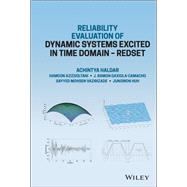Multi-disciplinary approach to structural reliability analysis for dynamic loadings offering a practical alternative to the random vibration theory and simulation
Reliability Evaluation of Dynamic Systems Excited in Time Domain – REDSET is a multidisciplinary concept that enables readers to estimate the underlying risk that could not be solved in the past. The major hurdle was that the required limit state functions (LSFs) are implicit in nature and the lack of progress in the reliability evaluation methods for this class of problems. The most sophisticated deterministic analysis requires that the dynamic loadings must be applied in the time domain. To satisfy these requirements, REDSET is developed. Different types and forms of dynamic loadings including seismic, wind-induced wave, and thermomechanical loading in the form of heating and cooling of solder balls used in computer chips are considered to validate REDSET. Time domain representations and the uncertainty quantification procedures including the use of multiple time histories are proposed and demonstrated for all these dynamic loadings. Both onshore and offshore structures are used for validation. The potential of REDSET is demonstrated for implementing the Performance Based Seismic Design (PBSD) concept now under development in the United States. For wider multidisciplinary applications, structures are represented by finite elements to capture different types of nonlinearity more appropriately. Any computer program capable of conducting nonlinear time domain dynamic analysis can be used, and the underlying risk can be estimated with the help of several dozens or hundreds of deterministic finite element analyses, providing an alternative to the simulation approach. To aid comprehension of REDSET, numerous illustrative examples and solution strategies are presented in each chapter. Written by award-winning thought leaders from academia and professional practice, the following sample topics are included:
- Fundamentals of reliability assessment including set theory, modeling of uncertainty, the risk-based engineering design concept, and the evolution of reliability assessment methods
- Implicit performance or limit state functions are expressed explicitly by the extensively modified response surface method with several new experimental designs
- Uncertainty quantification procedures with multiple time histories for different dynamic loadings, illustrated with examples
- The underlying risk can be estimated using any computer program representing structures by finite elements with only few deterministic analyses
- REDSET is demonstrated to be an alternative to the classical random vibration concept and the basic simulation procedure for risk estimation purposes
- REDSET changes the current engineering design paradigm. Instead of conducting one deterministic analysis, a design can be made more dynamic load tolerant, resilient, and sustainable with the help of a few additional deterministic analyses
This book describing REDSET is expected to complement two other books published by Wiley and authored by Haldar and Mahadevan: Probability, Reliability and Statistical Methods in Engineering Design and Reliability Assessment Using Stochastic Finite Element Analysis. The book is perfect to use as a supplementary resource for upper-level undergraduate and graduate level courses on reliability and risk-based design.








